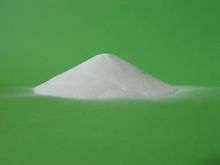Ammonium paratungstate
Ammonium paratungstate (or APT) is a white crystalline salt with the chemical formula (NH4)10(H2W12O42)·4H2O. It is described as "the most important raw material for all other tungsten products."[2]
 | |
| Identifiers | |
|---|---|
| ChemSpider | |
| ECHA InfoCard | 100.031.228 |
| EC Number |
|
PubChem CID |
|
| UNII | |
CompTox Dashboard (EPA) |
|
| |
| Properties | |
| (NH4)10(H2W12O42)·4H2O | |
| Molar mass | 3132.2 g/mol |
| Appearance | White solid |
| Density | 4.60 g/cm3[1] |
| Boiling point | Decomposes at 600 °C |
| Hazards | |
| GHS pictograms |  |
| GHS Signal word | Warning |
GHS hazard statements |
H315, H319, H335 |
| P261, P264, P271, P280, P302+352, P304+340, P305+351+338, P312, P321, P332+313, P337+313, P362, P403+233, P405, P501 | |
Except where otherwise noted, data are given for materials in their standard state (at 25 °C [77 °F], 100 kPa). | |
| Infobox references | |
Production
From tungsten ores
Tungsten ores, which are typically oxides, are digested in base to give solutions of tungstate together with many contaminating species. This crude extract is acidified and treated with sulfide to separate molybdenum trisulfide. Upon further acidification APT eventually crystallizes.[2]
Conversion to tungsten metal
Heating ammonium paratungstate to its decomposition temperature of 600 °C yields tungsten(VI) oxide, as described in this idealized equation:
- (NH4)10(H2W12O42)·4H2O → 12 WO3 + 10 NH3 + 6 H2O
From there, the trioxide is heated in an atmosphere of hydrogen, yielding elemental tungsten:[3]
- WO3 + 3 H2 → W + 3 H2O
Structure

The anion in (NH4)10(W12O41)·5H2O has been shown to be [H2W12O42]10−, containing two hydrogen atoms, keeping two hydrogen atoms inside the cage.[1] The correct formula notation for ammonium paratungstate is therefore (NH4)10[H2W12O42]·4H2O. The [H2W12O42]10− ion is known as the paratungstate B ion, as opposed to the paratungstate A ion, that has the formula [W7O24]6−, similar to the paramolybdate ion. The existence of the paratungstate A ion, could not be confirmed by NMR spectroscopy, however.[4]
Before about 1930, there has been some dispute about the exact composition of the salt, and both (NH4)10W12O41 and (NH4)6W7O24 were proposed. O.W. Gibbs remarked about this:
- "The alkali tungstates are numerous and unusually complex. Salts of essentially different formulae approach so closely in percentage composition, that the differences lie very near the unavoidable errors of analyses. The analyses are hardly sufficiently close to decide the question upon purely analytical grounds."[5]
Other hydrates
When concentrating an ammoniacal solution of tungstic acid (i.e. hydrous WO3), the product obtained is ammonium paratungstate. Below 50 °C, the hexahydrate is formed, whereas when the temperature of the solution is above 50 °C, the pentahydrate or heptahydrate is formed. The former crystallizes as triclinic plates or prisms, whereas the latter as pseudorhombic needles. The tetrahydrate is most significant in a commercial sense. Also known:
- decahydrate[6]
- nonahydrate
References
- d'Amour, Hedwig; Allmann, Rudolf (1972). "Die Kristallstruktur des Ammoniumparawolframat-tetrahydrats (NH4)10[H2W12O42]·4H2O". Zeitschrift für Kristallographie. 136 (1–2): 23–47. Bibcode:1972ZK....136...23D. doi:10.1524/zkri.1972.136.1-2.23.
- Lassner, Erick; Schubert, Wolf-Dieter; Lüderitz, Eberhard; Wolf, Hans Uwe. "Tungsten, Tungsten Alloys, and Tungsten Compounds". Ullmann's Encyclopedia of Industrial Chemistry. Weinheim: Wiley-VCH. doi:10.1002/14356007.a27_229.
- D. J. Jones, "Practical aspects of Sintering Tungsten and Molybdenum" (as referenced in Comprehensive Inorganic Chemistry, J. C. Bailar Jr. et al., p. 744, vol. 3, 1st edition 1973)
- Greenwood & Earnshaw, Chemistry of the Elements, 2nd ed. 1997, pp. 1012–1014
- J. W. Mellor: Inorganic and Theoretical Chemistry, vol. XI, p. 812–813, Longmans Green & Co. 1931
- Allmann, R. (1971). "Die Struktur des Ammoniumparawolframates (NH4)10[H2W12O42].10H2O". Acta Crystallographica Section B. 27 (7): 1393–1404. doi:10.1107/S0567740871004047.